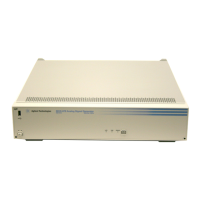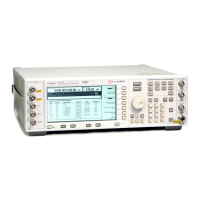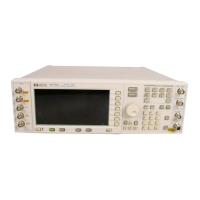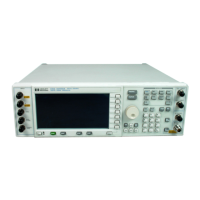150 Agilent N5181A/82A MXG Signal Generators SCPI Command Reference
Component Test Digital Commands
Dual ARB Subsystem–Option 651/652/654 ([:SOURce]:RADio[1]:ARB)
For more information on the marker ALC hold function, see the User’s Guide. For setting the marker
points, see “:MARKer[:SET]” on page 147.
NONE This terminates the marker ALC hold function.
M1–M4 These are the marker choices. The ALC hold feature uses only one marker at a
time.
*RST NONE
Example
:RAD:ARB:MDES:ALCH M1
The preceding example routes marker 1 to the ALC Hold function.
:MDEStination:PULSe
Supported N5182A with Option 651/652/654
CAUTION The pulse function incorporates ALC hold. Incorrect automatic level control (ALC)
sampling can create a sudden unleveled condition that may create a spike in the RF
output potentially damaging a DUT or connected instrument. Ensure that you set
markers to let the ALC sample over an amplitude that accounts for the high power levels
within the signal.
[:SOURce]:RADio[1]:ARB:MDEStination:PULSe NONE|M1|M2|M3|M4
[:SOURce]:RADio[1]:ARB:MDEStination:PULSe?
This command enables or disables the marker pulse/RF blanking function for the selected marker.
This function automatically uses the ALC hold function, so there is no need to select both the ALC
hold and pulse/RF blanking functions for the same marker.
NOTE Do not use ALC hold for more than 100 ms, because it can affect the waveform’s output
amplitude.
The signal generator blanks the RF output when the marker signal goes low. The marker polarity
determines when the marker signal is low. For a positive polarity, this is during the marker points.
For a negative polarity, this is when there are no marker points. For setting a marker’s polarity, see
“:MPOLarity:MARKer1|2|3|4” on page 151.
NOTE Set marker points prior to using this function. Enabling this function without setting marker
points may create a continuous low or high marker signal, depending on the marker polarity.
This causes either no RF output or a continuous RF output. See “:MARKer[:SET]” on
page 147 for setting the marker points.
The marker signal has a minimum of a two- sample delay in its response relative to the waveform
signal response. To compensate for the marker signal delay, offset marker points from the waveform
sample point at which you want the RF blanking to begin. The RF blanking setting is part of the file
header information, so saving the setting to the file header saves the current marker routing for the
waveform file.
Key Entry None Marker 1 Marker 2 Marker 3 Marker 4
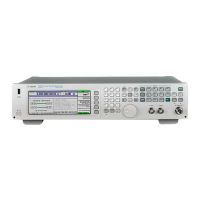
